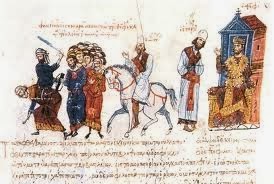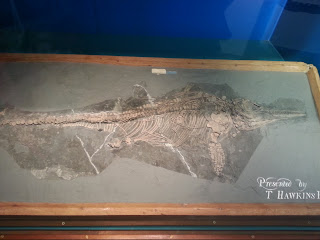It is an
oft repeated lesson of history that those who usurp the royal power often show
the way to those who would usurp them in turn. With the overthrow of a dynasty
somehow a spell is broken and the crime of regicide loses its awful gravity. So
it was with Leo V, who through skulduggery at the Battle of Versinicia in 813, had engineered the downfall of emperor Michael I and thereafter ushered in the second era of iconoclasm.
Michael I and Leo V - Madrid Skylitzes
A story
is told by the anonymous continuator of the chronicle of Theophanes the
Confessor of how, many years earlier, back in the reign of Nicephorus I, three
men accompanied the would-be rebel Bardanes Turkos to seek the advice of just
such a hermit as he plotted his revolt. The hermit is said to have advised
Bardanes against his rebellion but prophesised that his three companions; Leo,
Michael and Thomas would all attain the purple, although Thomas, he warned,
would never sit upon the throne. Bardanes’ revolt against Nicephorus failed and
he was blinded and stripped of his property just as the old hermit had
predicted.
If Leo
gave any credence to this prophesy, if indeed such a prophesy there was, then it did not
prevent him from elevating the two men who had accompanied him that day to high
office under his rule. Michael, known as the Stammerer, was appointed Count of
the Excubitors; commander of the imperial bodyguard and one of the most senior
military positions within the empire. More than one former incumbent of this
position had risen to claim the throne in the past. Thomas, known as the Slav,
was appointed to Leo’s former command of the elite regiment of the Foederati.
Michael,
not content with his station, soon began plotting to seize the throne for
himself but proved to be loose tongued and incautious in company
and drunkenly declared his intentions in the hearing of those who would report
his words back to the emperor. On Christmas Eve 820, Michael was arrested and charged with
plotting against his friend the emperor. He confessed all. Placed under guard in chains, Michael
was left to await a truly terrible fate. He was to be executed by being thrown
into the furnace beneath the baths of Zeuxippos the next day. It was the
empress Theodosia, we are told, who fatefully interceded for Michael, imploring
Leo not to taint his rule with such a savage act on the sacred feast of
Christmas day. Leo too was troubled by the judgement he had passed upon his former
friend and spent a sleepless night. He agreed to put off the execution until
after the Christmas festivities. It would prove a fatal delay. During the
night, Michael’s supporters put a conspiracy into action. Under the pretext of
the prisoner wishing to confess his sins, a priest was sent for from the city.
The servant sent to bring the priest summoned a number of conspirators who,
disguised as monks, made their way into the Daphne palace complex and entered
the chapel of St Stephen, where the emperor would celebrate a dawn mass.
As the
emperor arrived for morning prayers the conspirators drew swords from under
their habits and set upon him. In the confusion the priest was struck down
instead of the emperor, who grabbed a large cross from the alter and
wielded it desperately against his attackers. It was to no avail however and a
mighty blow severed Leo’s arm, with his hand still gripping the cross. Falling
to the floor, the emperor was beheaded.
Michael II receiving a delegation from the Bulgars - Madrid Skylitzes
Michael
was carried from his prison cell and then sat upon the
throne to receive oaths of loyalty with the fetters still upon his legs. Not
until mid day was he released from his chains in order to make his way to St
Sophia where a scandalised but compliant Patriarch placed the crown of empire
upon his head.
When news
of Michael’s usurpation reached the ears of Thomas the Slav, he gave no heed to
any doom-mongering predictions of his ultimate failure that he may have
received in the past and immediately raised the standard of revolt in the
eastern provinces of the empire. It is difficult to separate the truth of
Thomas’ motives from the propaganda put about by himself and his enemies. It
seems probable however that Thomas sought to be all things to all people in
order to gain for himself the widest possible base of support.
At times Thomas
is said to have claimed to be the murdered emperor Constantine VI back from the
dead, although surely he would have been too well known a figure in his own
right to pull this subterfuge off with any but the most credulous of peasants
and it is likely to be a later fabrication. In the east he presented himself as
the avenger of the murdered Leo and the champion of the poor and oppressed. In
the west, where anti-iconoclast opinion prevailed, his supporters hinted that
he would be sympathetic to the cause of the restoration of the icons. Despite
the fact that Thomas’ base of Amorion in the Anatolian heartland of the empire
was the home town of Michael, supporters flocked to his side. Thomas was by all
accounts a charismatic leader and soon almost every Anatolian theme, as
Byzantine military provinces were known, had thrown their lot in with the
rebel.
In 821
Thomas marched into Syria at the head of his considerable forces in a show of
strength calculated to impress. Here too, the chameleon-like Thomas presented
himself to best effect to gain the friendship of the Caliph Al-Mamun. His
emissary to the Caliph was sent with extravagant promises to make. Allowing for
propaganda intended to blacken his name as a traitor to the empire, Thomas is
variously credited with signing away frontier provinces or perhaps even
undertaking to en-fief the entire empire to the Caliphate in exchange for an
alliance which would safeguard his rear whilst he turned his forces against
Constantinople. The Caliph accepted with alacrity and provided Thomas with a
substantial contribution to his war chest. The rebel was even permitted to
celebrate his coronation as Emperor of the Romans in the city of Antioch. Al
Ma’mun would have been advised to remain sceptical of the bargain. Thomas,
after all, was not the first Byzantine rebel commander to promise much and deliver
nothing. Leo III had struck a similar bargain a century before. At any rate
Thomas’ friendly overtures were well timed for the Caliph had his hands full
already with the rebellion of Barbak.
With
peace secured and having defeated a loyalist army from the Armeniakon Theme,
Thomas turned his vast polyglot army which may have been as large as 80,000
men, against Constantinople. The fleets stationed along the eastern shore of
the Marmara also declared for Thomas and so he was able to ferry his troops
across the straits and lay siege to the land walls at Blacharnae. The defences
here proved too strong for the attackers however and the massive catapults
stationed on the towers wrecked destruction on every engine of war that Thomas
was able to send against them. Just as it had seemed that the resolve of the
defenders was weakening and the emperor Michael had appeared upon the walls in
person to deliver a heartfelt plea for peace to the besiegers, lulling them
into a false sense of security, a sortie launched from the gates fell upon the
disorganised rebels and inflicted much slaughter upon them. At sea too Thomas’
forces were bested by the loyalist fleet and many of his ships were destroyed
by Greek Fire. The siege dragged on through 822 and the besiegers endured a
second miserable winter outside the walls before in the following spring came
the fatal blow. From out of the west, falling like a hammer blow upon the
rebel’s rear, came the army of Ormortag, son of Krum, who had been unable to
resist the lure of easy plunder and come to Michael’s assistance. The Bulgar
attack shattered Thomas’ army which withdrew westwards with the emperor’s
forces hot on their trail; Michael himself at their head.
Thomas besieges Constantinople - Madrid Skylitzes
Two years
later worse was to follow when a disgraced admiral in Sicily by the name of
Euphemius provoked the wrath of the governor by eloping with a nun. The penalty
for his offence was rhinocopia and rather than be deprived of his nose,
Euphemius launched a revolt against imperial power. When his plans began to
unravel, Euphemius escaped to North Africa and plotted with the Emir of
Kairouan to conquer the island between them. Euphemius would then rule Sicily
as the Emir’s vassal. The rebellious admiral then returned to Sicily backed by
an Arab invasion force of ten thousand men. Euphemius, dressing himself in
imperial regalia and styling himself emperor, came to a sticky end as his
forces advanced on Syracuse. Arriving to accept the surrender of the town of
Castrogiovanni, Euphemius was approached by a welcoming committee of two young
men of the town, who prostrated themselves before him. As he bent his head to
bestow a sovereign’s kiss upon the brow of one of the men, Euphemius was
summarily beheaded by the other, reflecting perhaps in his last moments on the
irony of his fate. The course that he had taken to avoid the loss of his nose
had led in the end to the loss of his head. Another usurper had been dispatched
but the damage was done. The Arab invaders were not so easily removed and with
a firm foothold established in Sicily they would continue to gain ground on the
island over the ensuing half century until they made it their own.
Theophilus condemns the assassins - Madrid Skylitzes
Upon his
accession Theophilus gave a stark and unmistakable demonstration of his
commitment to the rule of law. Summoning the great and the good to appear
before him in the great vaulted audience hall of the Magnaura, Theophilus
declared that he wished to reward those who had loyally supported his father.
He called forth those who had participated in the murder of Leo nine years
before and proudly the men stepped forward, eagerly expecting the new
emperor to bestow gifts and honours upon
them. Instead Theophilus called upon the Eparch of the city, responsible for
maintaining law and order, to have the men seized and declaring:
‘Go to it Eparch! You have authority from God and
from our own serenity to pass judgement on these persons and to reward them
according to their deeds: not only for having stained their hands with human
blood, but also because they slew the lord’s anointed within the sanctuary.’
It was a
remarkable act. From the unlikeliest of quarters; the hands of the son of the
man who had usurped him, Leo V had received his justice. For Theophilus
perhaps, it was an act without which he could not feel that his accession to
the throne was legitimate, tainted as it was by the heinous crime of Leo’s
murder. Having seen justice done, he could set about ruling his empire with his
hands washed clean.































